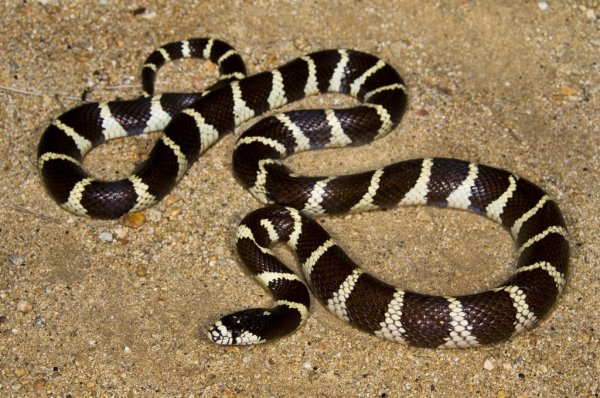ANIMAL: California Kingsnake Lampropeltis californiae Type of Animal: Colubrid Habitat: Desert, woodland, grassland, mountains, forests, chaparral, marshes, farmland, ranches, brushy suburbs, coastal scrub, riverine wetlands, shrubland, valleys, coastal estuaries, ponds, quiet streams, rolling hills, desert basins Location(s): California, S.W. US, & Baja California. Invasive on Gran Canaria on Canary Islands. Appearance: Black w/ 20-47 white bands, cylindrical body. 4 main morphs-banded, striped, unicolored, and blotched. Females heavier & longer than males, male has longer tail. Food/Diet: Mainly on other snakes-even other kingsnake species, venomous snakes, & each other. Also feed on amphibians, turtles, baby tortoises, rodents, rabbits, birds, & eggs. Status in Wild: Stable Conservation: Breeding on reptile farms & zoos. Captive breeding reducing demand to take animals from wild. Lifestyle: Solitary Additional Info: Called: Male Female Young-Snakelet Group-Solitary Weight: Male-2.8 lbs Female-3.3 lbs Gestation: 2 months Body Length: Male- 3.5-4.5 ft Female- 5-6 ft Young- 0.83-1.16 ft Life Span: 18-20 years Tail Length: Male-6.84-8.04 in Female-4.8-6 in Main predators are raptors, roadrunners, raccoons, badgers, bobcats, coyotes, larger snakes, pigs, & skunks. These non-venomous snakes usually kill prey by constriction. Females usually lay around 15 eggs per season. Breeding season occurs in late spring or early summer. Sexually mature at 1-3 years old. Can be active during the day & at night. Beneficial due to habit of eating venomous snakes & crop pests. Mainly terrestrial but will climb low branches/shrubs sometimes. When young kingsnakes hatch, they’re immediately on their own In parts of range, they hybridize w/ desert & Mexican black kingsnakes. Like many snakes, sometimes persecuted/killed by people. Juveniles shed more often than adults (up to once a month). They hibernate in cooler weather. Fun Fact(s): Many color phases have been bred, including albino. Almost impervious to snake venom. Very common in pet trade. They’re generally very docile. Name “king” comes from habit of eating other snakes. To warn an attacker, it will hiss, bite, or smear feces. Sometimes, they’ll play dead. Other times, they’ll discharge a foul musk.
